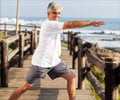Exercise may reduce the ill effects of unhealthy sleep duration in the long run.
- Good sleep and physical activity are needed to live a healthy life
- A recent study says that working out could actually counter the toll of too much or too little sleep
- The duration of sleep was not linked to death in people who engaged in high amounts of exercise
Joint association of physical activity and sleep duration with risk of all-cause and cause-specific mortality: a population-based cohort study using accelerometry
Go to source).
Exercise May be able to Counter the Effects of Too Much or Too Little Sleep
“The study showed that increased physical activity levels weakened the mortality risks associated with short or long sleep duration,” said study author Dr. Jihui Zhang of The Affiliated Brain Hospital of Guangzhou Medical University, China.Both sufficient exercise and healthy sleep contribute to prolonged life expectancy. However, it has been unclear how physical activity may interact with sleep duration to promote health.
Previous studies used self-reported physical activity and sleep, which are subjective and may be inaccurate. In contrast, an accelerometer device records movement, thereby providing objective and more reliable estimates of activity and sleep duration.
This was the first study to examine the joint effects of physical activity and sleep duration on mortality risk using accelerometry. The study included 92,221 adults aged 40 to 73 years in the UK Biobank cohort who wore an accelerometer wristband for one week between 2013 and 2015.
How much Sleep is Enough Sleep?
Sleep duration per night was classified as short (less than six hours), normal (six to eight hours) or long (more than eight hours). The total volume of physical activity was divided into tertiles (low, intermediate,and high). Moderate to vigorous physical activity was classified as meeting World Health Organization (WHO) guidelines or not (2✔ ✔Trusted SourcePhysical activity
Go to source). Mortality data were collected from death registries. The primary outcome was all-cause death. The secondary endpoints were death due to cardiovascular disease and death due to cancer.
The average age of participants was 62 years and 56% were women. During a median follow up of seven years, 3,080 participants died – 1,074 from cardiovascular disease and 1,871 from cancer.
The researchers examined how physical activity influenced sleep’s impact on mortality – first looking at the volume of activity and second at moderate to vigorous physical activity. The analyses were adjusted for factors that could influence the relationship including age, sex, ethnicity, deprivation, education level, season of sleep measurement, body mass index, diet, smoking, alcohol intake and shift work.
Moderate to High Exercise can Prevent Mortality Even if Sleep is Compromised
Regarding the volume of activity, in those with low amounts, short and long sleep were associated with 16% and 37% raised risks of all-cause death, respectively. In participants with intermediate amounts of exercise, only short sleep was detrimental, with a 41% raised likelihood of all-cause death.For the people with high amounts of exercise, sleep duration was not linked with a higher risk of death.
For cardiovascular death, short sleepers with a low volume of exercise had a 69% elevated risk, which disappeared when exercise increased to moderate or high volumes.
For cancer death, long sleepers with low amounts of exercise had a 21% raised risk which disappeared with moderate or high volumes of exercise.
Similar results were found for moderate to vigorous physical activity. In participants not meeting the WHO recommendations, short and long sleep were associated with 31% and 20% raised risks of all-cause death, respectively. These risks disappeared in those meeting the WHO advice. For cardiovascular death, short sleepers who failed to meet the advice on intensity of exercise had a 52% elevated risk, which disappeared in those achieving the recommendations. For cancer death, long sleepers not meeting the advice had a 21% raised risk which disappeared in those following the WHO guidance.
Good Sleep and Physical Activity go Hand in Hand
Dr. Zhang said: “Our findings suggest that health promotion efforts targeting both physical activity and sleep duration may be more effective in preventing or delaying premature death in middle-aged and older adults than focusing on one behaviour alone. In an ideal scenario, people would always get healthy amounts of both sleep and physical activity. However, our study indicates that getting sufficient exercise may partially offset the detrimental impact of missing a good night’s sleep.”References:
- Joint association of physical activity and sleep duration with risk of all-cause and cause-specific mortality: a population-based cohort study using accelerometry - (https://academic.oup.com/eurjpc/advance-article/doi/10.1093/eurjpc/zwad060/7086191)
- Physical activity - (https://www.who.int/news-room/fact-sheets/detail/physical-activity)
Source-Medindia
















